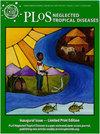坦桑尼亚大陆和桑给巴尔各地区的人类血吸虫病流行情况:对过去十年(2013-2023 年)所做研究的系统回顾和荟萃分析
IF 3.4
2区 医学
Q1 Medicine
引用次数: 0
摘要
血吸虫病是坦桑尼亚的一个重大公共卫生问题,对于生活在边缘化环境中的人来说尤其如此。我们对血吸虫病的流行情况进行了系统回顾和荟萃分析,以便为坦桑尼亚制定有效的疾病控制方法提供更多知识。我们系统地搜索了 Pub Med、SCOPUS 和 AJOL 等在线数据库,并使用随机效应模型计算了该疾病的总体流行率。异质性和研究间方差分别通过 Cochran (Q) 和 Higgins (I2) 检验来确定。共有 55 篇文章符合本综述的纳入标准,所有文章的质量评分均令人满意。坦桑尼亚血吸虫病的总发病率为 26.40%。坦桑尼亚大陆的血吸虫病流行率(28.89%)高于桑给巴尔岛(8.95%)。根据发表年份进行的分组分析显示,汇总流行率有所上升,其中(2013-2018年)和(2018-2023年)的流行率分别为23.41%和30.06%。曼氏血吸虫和血吸虫的流行率分别为 37.91% 和 8.86%。马拉、西姆尤和姆万扎是发病率最高的地区,综合发病率分别为 77.39%、72.26% 和 51.19%。根据诊断方法得出的汇总流行率,PCR 为 64.11%,POC-CCA 为 56.46%,与其他检测方法相比相对较高。Cochrans和Higgins(I2)检验显示存在显著异质性(P值=0.001,I2=99.6)。年龄、地区、诊断方法和样本量等因素对所显示的异质性有重要影响。该疾病的发病率明显增高,表明其覆盖率可能较低,某些地区可能没有参与该疾病的控制。因此,需要在所有流行地区大力实施控制干预措施,最好采用针对疾病生命周期几个阶段的综合方法。本文章由计算机程序翻译,如有差异,请以英文原文为准。
Prevalence of human schistosomiasis in various regions of Tanzania Mainland and Zanzibar: A systematic review and meta-analysis of studies conducted for the past ten years (2013–2023)
Schistosomiasis is a significant public health problem in Tanzania, particularly for the people living in the marginalized settings. We have conducted a systematic review with meta-analysis on the prevalence of schistosomiasis to add knowledge towards the development of effective approaches to control the disease in Tanzania. Online databases namely, Pub Med, SCOPUS and AJOL, were systematically searched and a random effect model was used to calculate the pooled prevalence of the disease. Heterogeneity and the between studies variances were determined using Cochran (Q) and Higgins (I2 ) tests, respectively. A total of 55 articles met the inclusion criterion for this review and all have satisfactory quality scores. The pooled prevalence of the disease in Tanzania was 26.40%. Tanzania mainland had the highest schistosomiasis prevalence (28.89%) than Zanzibar (8.95%). Sub-group analyses based on the year of publication revealed the going up of the pooled prevalence, whereby for (2013–2018) and (2018–2023) the prevalence was 23.41% and 30.06%, respectively. The prevalence of the Schistosoma mansoni and Schistosoma hematobium were 37.91% and 8.86% respectively. Mara, Simuyu, and Mwanza were the most prevalent regions, with a pooled prevalence of 77.39%, 72.26%, and 51.19%, respectively. The pooled prevalence based on the diagnostic method was 64.11% for PCR and 56.46% for POC-CCA, which is relatively high compared to other tests. Cochrans and Higgins (I2 ) test has shown significant heterogeneity (p-value = 0.001 and I2 = 99.6). Factors including age, region, diagnostic method and sample size have shown significant contribution to the displayed heterogeneity. The pronounced and increasing prevalence of the disease suggests potential low coverage and possibly lack of involvement of some regions in the control of the disease. This, therefore, calls for an intensive implementation of control interventions in all endemic regions, preferably using an integrated approach that targets several stages of the disease lifecycle.
求助全文
通过发布文献求助,成功后即可免费获取论文全文。
去求助
来源期刊

PLoS Neglected Tropical Diseases
Medicine-Infectious Diseases
CiteScore
7.40
自引率
10.50%
发文量
723
审稿时长
2-3 weeks
期刊介绍:
PLOS Neglected Tropical Diseases publishes research devoted to the pathology, epidemiology, prevention, treatment and control of the neglected tropical diseases (NTDs), as well as relevant public policy.
The NTDs are defined as a group of poverty-promoting chronic infectious diseases, which primarily occur in rural areas and poor urban areas of low-income and middle-income countries. Their impact on child health and development, pregnancy, and worker productivity, as well as their stigmatizing features limit economic stability.
All aspects of these diseases are considered, including:
Pathogenesis
Clinical features
Pharmacology and treatment
Diagnosis
Epidemiology
Vector biology
Vaccinology and prevention
Demographic, ecological and social determinants
Public health and policy aspects (including cost-effectiveness analyses).
 求助内容:
求助内容: 应助结果提醒方式:
应助结果提醒方式:


